Marie Rama's Blog, page 4
April 1, 2014
Enjoying The Recipe Testing Process
Tips, recipes, notes, stories for and about professional recipe testers in The Cook’s Cook, an online food magazine published by Denise Landis.
http://thecookscook.com/the-cook-tests/enjoying-the-recipe-testing-process/
March 29, 2014
The Cronut? The Cragel? The Bacon Jelly Donut?
Which of these food hybrids would you buy? There’s a market out there for new desserts or baked goods that merge two treats, like a donut and a croissant, to create an offspring with a clever moniker, like the Cronut.
What would you crossbreed?
I’d create the bacon jelly donut. It would be like a jelly donut, but filled with a sweet jam of bacon, brown sugar, fresh ginger and assorted seasonings. Instead of sugar, the top would be sprinkled with sweetened bits of browned bacon.
Does anybody like this idea, and if you do, what would you name it?
Here’s a link to a NYT’s story for other hybrid desserts and trends.
March 26, 2014
Funny Bacon Cartoon
Julia Child Got It Right!
Butter (and bacon) is fine; margarine and other man-made foods are not. Eat real food as your grandparents did 100 years ago. Read Mark Bittman’s piece in the NYTimes.
March 24, 2014
Preserved Lemons: A Connector to Another World
My good friends Richard Bonomo and Marla Hazan, whose ancestors are Sephardic Jews from exotic, far-away lands like Turkey, Spain, and Morocco, always have a jar of preserved lemons in their kitchen, for flavoring stews, soups, salads, sauces, marinades and dressings.
I am working on a 5th edition of Cooking for Dummies with my co-author Bryan Miller, and for a chapter on international cuisines we are exploring and explaining some of the ingredients and techniques used in Mediterranean cooking. Lemons, both fresh and preserved with salt, are as ubiquitous as olive oil and tomatoes throughout the entire Mediterranean world.
I set out this last weekend to preserve some lemons myself and to also borrow some from Richard and Marla so I could add them to the Chicken and Green Olive Tagine I created for Cooking for Dummies V. I don’t know if it’s just me, (I admit to being a bit quirky), but when I make a dish like preserved lemons, the process pleasantly carries me back and connects me to a culture and kitchen practices that are tried and true and centuries old. I become a little Moroccan, a little Turkish, a little Mediterranean.
Preserved Lemons
4 medium, thick-skinned lemons
About 6 tablespoons (not iodized) salt
Juice of 4 lemons, or more if needed
1.) Scrub the lemons well. Using a sharp knife slice the lemons into quarters, stopping about ½-inch from one end to leave the quarters attached to the fruit.

Pack about 1 tablespoon of salt into the center of each cut lemon.
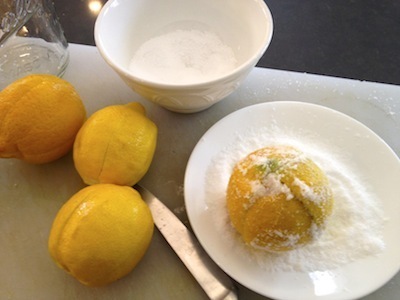
Place them in a one-quart, wide-mouth mason jar, fitted with a lid, and press them down so they fit snuggly.
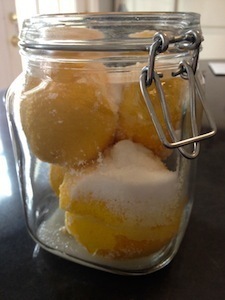
2.) Sprinkle them with one additional tablespoon of salt. Add the lemon juice and press them gently into the juice as much as possible. Cover the jar and let set 3 to 4 days, turning the jar over a couple of times a day, during which time they will soften and release their juice.
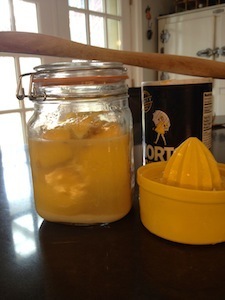
3.) Press them down again and add 1 more tablespoon salt and additional juice, if necessary to completely cover. Close the jar and let set for at least one month, turning the jar over every few days to redistribute the salt and juices. Before using, remove and discard the pulp, then rinse the rind well. A harmless white mold may appear on the fruit; simply rinse it off before cutting up and using the peel. After opening, preserved lemons will keep up to a year, without refrigerating. The pickling juices can be used to make salad dressings or marinades for vegetable salads.
Tip: Cut up the juiced lemon rinds, and if you have a rose garden compost them into the soil around the roots of the plant. Roses love the acidity of lemon peel.
March 18, 2014
From White House Pastry Chef to Food Educator in Health
Whatever Bill Yosses decides to do next in his remarkable culinary career, he’ll succeed at. I wish him the best of luck. Read about his transition from the White House:
http://www.nytimes.com/2014/03/19/us/politics/white-houses-top-pastry-chef-to-leave-post.html?hp
A new study questioning the link between heart disease and saturated fat is good news for those of...
A new study questioning the link between heart disease and saturated fat is good news for those of us who love our bacon.
March 17, 2014
The Important Quest to Turn Farmed Fish into Vegetarians
The diet of anchovies and other small fish fed to farmed fish like salmon is depleting our oceans of an important
March 13, 2014
Bacon Freak Ships Right to Your Door
It can be hard to find really unique kinds of bacon in even a good-size supermarket. Bacon Freak, an online bacon store, devoted to everything bacon, will ship an assortment of different flavored bacons and bacon-related products directly to your home. These make great gifts for you or those you love who love bacon.
I opened my package just now and was delighted that the bacon was shipped in a cardboard box with protective cold gel packs, a leaflet of handling and storing instructions, and a very usable recipe card for oven cooking bacon and storing or disposing of bacon grease — all of it personally packed by “Tanya.”

In Bacon Freak’s Sweet Pepper Bacon Jerky I tasted complimentary notes of cinnamon, black pepper, soy sauce, sweetness of brown sugar and honey, and of course the satisfying meatiness of thin bacon strips. Truthfully, I didn’t think I was going to like it, but their jerky is like potato chips; one bite and you can’t stop eating. Whoever made this bacon jerky worked really hard to get the flavors just right.
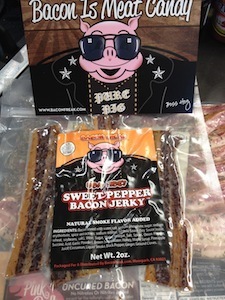
Can’t wait to try their Pan Fried Pier Summer Herb Bacon …
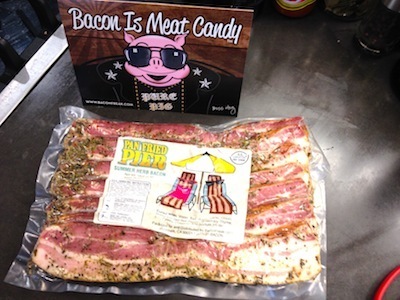
and their Pink Belly Thick-Cut Hickory Smoked Uncured Bacon …
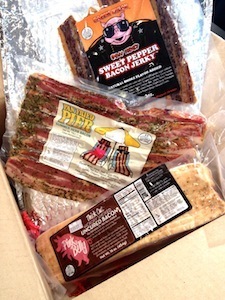
To get in touch with the folks at Bacon Freak go to www.baconfreak.com or call (877) 21-BACON. (Now that’s a number worth remembering!)
Happy Cooking with Bacon!
February 26, 2014
A Special Occasion Bacon Stuffed Pork Roast

Bacon Nation’s Pork Roast Stuffed with Bacon and Black Mission Figs
Serves 8 to 10
Most of the recipes in Bacon Nation fall within the range of easy to moderately difficult to prepare. This bacon and black mission fig pork roast is a bit complex, not because there are any tricky techniques, but because it calls for a bunch of different steps, from brining the pork to making the stuffing, to stuffing the pork and then finally tying and roasting it. But don’t be discouraged by my introduction. It’s so worth your time and effort, and I’ve given you all the information you need, even if you’re a beginner cook, to pull it off!
Roast pork can be succulent and delicious but too often it can turn out dry. Brining it is a pretty failsafe method to produce juicy, flavorful pork and it knocks the ball out of the park in this recipe. Honey contributes beautiful floral notes in the brine in addition to sweetness. The simple rosemary-garlic rub adds a herbaceous accent. The truly memorable flavor that makes this recipe a standout is the stuffing of bacon and figs: fruity, supremely soft, salty, smoky.
Ingredients:
For the pork roast and brine
6 tablespoons honey
2/3 cup Diamond Crystal kosher salt (see recipe note below)
6 bay leaves
8 medium-size cloves garlic, peeled and lightly crushed with the flat side of a chef’s knife
1 1/2 teaspoons fennel seeds (optional)
1 tablespoon black peppercorns
1 center-cut boneless pork loin roast (about 3 1/2 pounds)
For the bacon and fig stuffing (see note below)
6 slices bacon, diced
1 medium-size onion, diced (about 1 cup)
1 large shallot, diced
8 ounces dried black Mission figs, stems removed and discarded, cut into ¼- to ½-inch pieces
3 tablespoons granulated sugar
1 packed tablespoon dark brown sugar
6 tablespoons balsamic vinegar
1 bay leaf
Freshly ground black pepper
1 tablespoon extra-virgin olive oil
2/3 cup coarse-ground homemade bread crumbs
1/3 cup chopped fresh flat-leaf parsley
1 tablespoon Armagnac or Cognac (optional)
For the herb oil rub
2 tablespoons extra-virgin olive oil
1 tablespoon chopped fresh rosemary leaves
1 large clove garlic, finely chopped
1/4 teaspoon table salt
1/8 teaspoon black pepper
Directions:
1 Brine the pork: Combine the honey, 2/3 cup of kosher salt, 6 bay leaves, 8 cloves of garlic, fennel seeds, if using, peppercorns, and 4 cups of water in a large pot. Cover the pot, let come to a boil over high heat, and let boil for about 1 minute, stirring occasionally to dissolve the salt. Remove the brine mixture from the heat and stir in 4 more cups of water. Refrigerate the brine or place it in the freezer to cool to room temperature. Pour the brine into a ceramic or glass bowl or other nonreactive container large enough that the pork roast can be completely submerged. Add the pork, cover the bowl loosely with plastic wrap, and refrigerate the pork for 6 to 8 hours (longer brining may cause the pork to become too salty).
2 Remove the pork from the brine and rinse it under cold water. Pat the pork dry with paper towels and discard the brine.
3 Prepare the bacon and fig stuffing: Cook the bacon in a large heavy-bottomed saucepan over medium heat until the bacon is lightly browned and most of the fat is rendered, 5 to 8 minutes, stirring often and adjusting the heat as necessary. Using a slotted spoon, transfer the bacon to a paper towel-lined plate to drain, reserving the bacon fat in the saucepan. You should have 1 to 2 tablespoons of fat. If there’s more, pour off and discard the excess.
4 Heat the bacon fat in the saucepan over low heat. Add the onion and shallot and cook, stirring occasionally, until the onion is very soft and lightly browned at the edges, 8 to 10 minutes.
5 Add the drained bacon, figs, granulated sugar, brown sugar, balsamic vinegar, bay leaf, and 1/2 cup of water to the saucepan and season with pepper to taste. Cover the pan and bring to a boil over high heat. Then, reduce the heat as necessary to maintain an even simmer and cook, uncovered, until most of the liquid has evaporated, 20 to 25 minutes, stirring occasionally. …
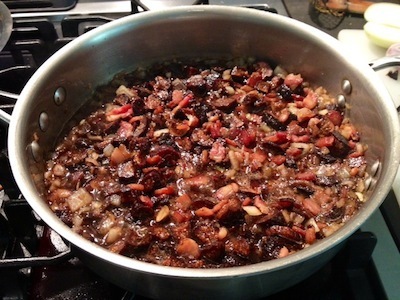
… Remove and discard the bay leaf, transfer the stuffing mixture to a medium-size bowl, and let cool for about 10 minutes.
6 Heat the 1 tablespoon of olive oil in a small skillet. Add the bread crumbs and cook over low heat until evenly browned, 3 to 4 minutes, stirring often. Stir the browned bread crumbs and the parsley and Armagnac or Cognac, if using, into the fig mixture. If desired, season with additional pepper to taste. Set the stuffing aside to cool completely (you will have about 21/2 cups stuffing).
7 Make a pocket in the pork roast for the stuffing. Starting at one end and using a long knife (a boning knife works well for this), insert the blade through the center of the roast, making a 1 1/2- to 2-inch-wide horizontal cut that runs from one end of the roast to the other. (If you find it easier, make 2 cuts halfway into the meat, working from each end of the roast toward the center so that the cuts meet in the middle.) Make another 1 1/2- to 2-inch-wide cut through the center of the roast so that it intersects the first cut, forming a cross. Place the pork in a large roasting pan.
8 Using your fingers, pry the cuts open to make a cavity for the stuffing. Stuff the roast, using the handle of a long wooden spoon to push the stuffing deep into the roast. Be sure to force the stuffing well into the middle to fill the center of the roast as well as you do the ends. It helps to work from both ends of the roast.
9 Preheat the oven to 400˚F and use butcher’s twine to tie the roast (see A Simplified Way of Tying a Boned Pork Roast on page 116 of Bacon Nation).
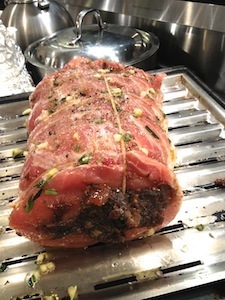
Make the herb oil rub: Place the 2 tablespoons of olive oil and the rosemary, chopped garlic, 1/4 teaspoon of table salt, and 1/8 teaspoon of pepper in a small bowl or measuring cup and stir to mix. Rub the stuffed pork roast all over with the oil and herb mixture.
Roast the pork for 15 minutes, then reduce the oven temperature to 350˚F and continue roasting the pork for 20 to 30 minutes longer. The roast will be done when an instant read meat thermometer inserted into the thickest part of the meat registers 135˚F, or 140˚F if you like your pork a little more cooked. The internal temperature will rise rapidly after the roast reaches 125˚F; monitor it closely to keep the pork from overcooking.
When done, transfer the pork roast to a cutting board. Cover the roast loosely with aluminum foil and let it stand for 15 to 20 minutes before removing and discarding the string. As the roast rests, the internal temperature will rise about 5˚F. Slice the roast and serve it immediately, drizzling any pan juices over the slices.
Recipe Note: We prefer Diamond Krystal Kosher salt to other brands.
Recipe Note: The bacon and fig stuffing can be prepared and refrigerated, covered, 1 to 2 days ahead of roasting the pork, but let the stuffing come to room temperature before stuffing the roast.
Happy Cooking with Bacon Nation! Marie Rama



